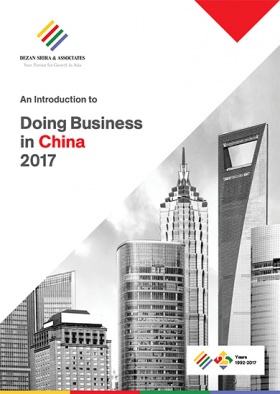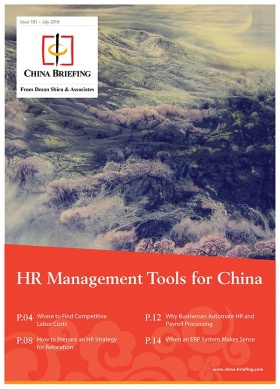Why Businesses Automate HR and Payroll Processing in China
Advances in automation are forcing businesses to reimagine their human resources (HR) and payroll processing workflows. Contrary to popular perceptions, automation will not replace employees, but rather compliment employee’s creative and critical skills – empowering them to be more productive.
Businesses can introduce automation into their organization through simple, practical applications that mechanize routine, monotonous tasks. Not only will this improve an organization’s level of productivity, but it will also prime both a business and its employees to be ready for further innovations in automation.
Changing the automation narrative
Automation has traditionally been associated with manufacturing and assembly. However, innovations in artificial intelligence (AI) and deep learning have widened the reach and scope of automation so that its potential can be felt from shop floors to head offices.
Unfortunately, workforces often express anxiety and even hostility towards technology’s growing reach – often, this is because of cynical, yet dominant, narratives associated with technological advances that posit images of mass layoffs and impossible learning curves. Contrary to popular belief, current automation regimes in HR and payroll are more likely to help human employees work than replace them.
According to a recent study of businesses in Asia Pacific by Willis Towers Watson, two thirds of employers believe that the goal of automation is to augment individual performance. Automation can help maximize employee productivity most directly not in information technology (IT) – as is commonly assumed – but in HR and payroll.
Both HR and payroll demand a combination of creative thinking and mundane, routinized work. This combination is not always mutually inclusive and can hamper an employee’s ability to effectively focus on tasks that require analytical thinking and problem solving.
Automating and streamlining some of these processes frees an employee’s time, providing the space necessary to effectively problem solve and tackle complex tasks. Free from mundane, time intensive processes, many companies are beginning to treat their HR departments as profit centers.
Preparing for automation
Two major misconceptions about automating business processes is that they will either require a major overhaul of an entire IT system or that the software will not be affordable to small and medium sized businesses.
In fact, many HR and payroll applications can easily integrate into existing IT infrastructure. Many professional services firms that offer payroll and HR support and consultancy also have the capacity to implement cost-effective IT solutions. Getting IT, payroll, and HR support from the same provider means a more integrated system with comprehensive troubleshooting and analytical reporting.
Alternatively, businesses can explore migrating their on-premise servers and business processes onto the internet through a ‘cloud’. Though cloud migration is a significant internal change, it will save businesses money in the long term – allowing them to adapt to new technologies more organically and without expensive upfront investments into physical infrastructure and hardware.
A practical approach to automation
To provide a clearer picture of what automated HR and payroll functions could look like for business, we asked Thomas Zhang, IT director of Dezan Shira & Associates, to explain several important, user-friendly applications businesses first look to when embracing automation.
Zhang is an IT expert who has overseen the development of Dezan Shira’s cloud-based integrated HR and payroll system Asia Admin.
Automated payroll systems
An automated payroll system should be able to automatically calculate employees’ payroll data and generate reports on this information for management. A data verification mechanism should be inbuilt to the application’s algorithm.
Such an application would save internal staff from having to manually fill in spreadsheets on a regular basis – a tedious though time consuming task with a high margin for human error. Reducing mistakes in payroll processing minimizes the risk of violating local regulations.
Automated HR
An automated HR system should be able to automatically process and standardize employee information without having to re-enter it manually across multiple platforms. This is of particular importance when dealing with offices that operate in multiple languages.
An automated HR also means simpler data collection – enabling staff to submit individual data on a self-service tool – as well as easily generated reports and employee profiles for management. HR applications should provide single portals for submitted, receiving and approving employee requests with built in notifications for both the supervisor and the employee.
Integrating HR and payroll systems
Integrating HR and payroll systems through automated applications facilitates the easy exchange of data between both systems.
If an employee takes an unpaid leave in the HR system, for example, this information will be automatically transferred to the payroll system when calculating the employee’s next salary payment. Similarly, if an employee receives a pay raise or bonus, the payroll system can readjust their salary without manual imputing the data a second time.
Company health and analytics
Automating key business processes means that mass amounts of a company’s raw data are processed and stored on a single, intelligent data point. An often overlooked benefit of automating HR and payroll processing is the company insights and analytics this data can produce. Additional applications, such as Microsoft’s Power BI, can visualize this data into graphs, charts, and infographics updated daily onto customized dashboards.
Stakeholders in a company’s home country can access always up-to-date analytics about their operations in Asia – ensuring informed decision-making, reducing the chances of fraud in remote offices, and improving knowledge sharing with offices separated by geography, time zones, and language.
This article was originally published in the latest issue of China Briefing magazine, titled “HR Management Tools for China“.
About Us
China Briefing is produced by Dezan Shira & Associates. The firm assists foreign investors throughout Asia and maintains offices in China, Hong Kong, Indonesia, Singapore, Russia, and Vietnam. Please contact info@dezshira.com or visit our website at www.dezshira.com.
- Previous Article Labor Cost Comparison of China’s First-Tier Cities
- Next Article How to Apply for CIT Incentives in China








